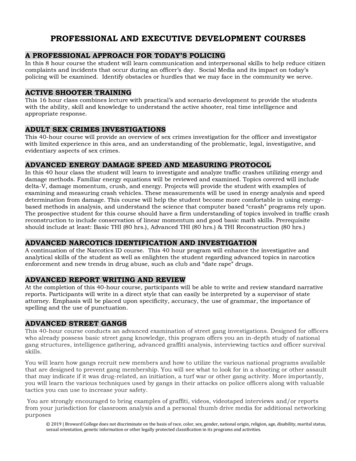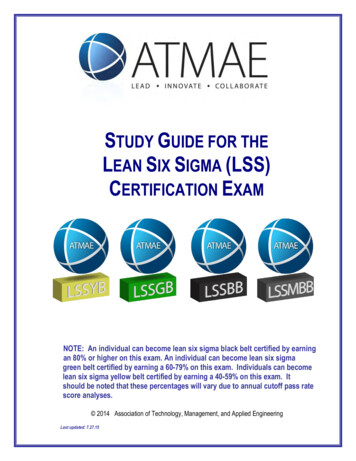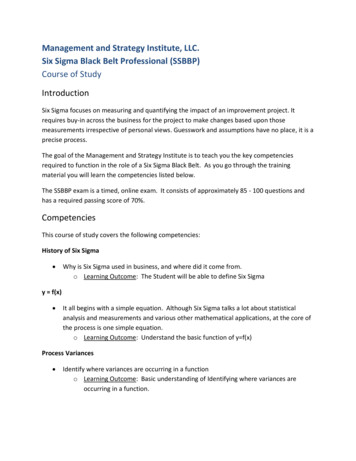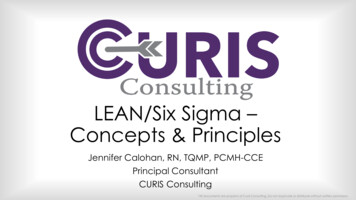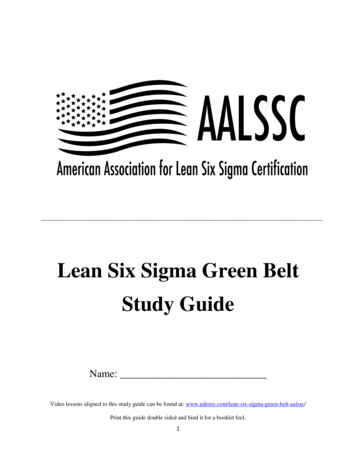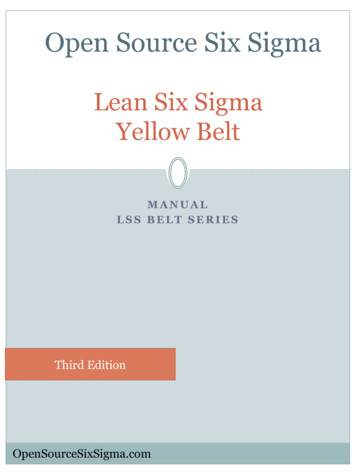
Transcription
Lean Six Sigma Training & CertificationSix Sigma CoursesProfessional Development Training has a specialised division of Six Sigmaexperts that will tailor the delivery of any of the courses to be specific to yoursituation and learning needs
Six Sigma CoursesLean Six SigmaIntroductionLean Six Sigma Yellow Belt CertificationTrainingLean Six Sigma Green Belt CertificationTrainingLean Six Sigma BlackBelt CertificationTrainingLean Six Sigma Team MembersTraining CourseLean Six Sigma Process ManagementTraining CourseLean Six SigmaAwareness TrainingCourseLean Six Sigma Champions CourseLean Six Sigma Project SelectionTraining CourseLean Six Sigma Executive BriefingLean Six Sigma Green Belt CertificationTraining Upgrade from Yellow BeltCourseLean Six Sigma Black Belt CertificationTraining Upgrade from Green BeltCourse
Essential Skills for Controlling Cost andManaging EfficiencyProfessional Development Training has a specialised division of Six Sigma experts that will tailorthe delivery of any of the courses to be specific to your situation and learning needs.Our extensive curriculum in Six Sigma, outstanding depth of trainers across the country anddiverse range of industry experience means that pd training is the best choice for Six Sigmacourses.pd training will exceed your expectations and help you achieve the results you are seeking.
Six Sigma is a data-driven approach for eliminating defects and waste in any business process.You can compare Six Sigma with turning on your water tap and experiencing the flow of clean, clear water. Reliablesystems are in place to purify, treat and maintain water pressure through the system. That is what Six Sigma does tobusiness: treats the processes in business so that they deliver their intended result.Lean Six Sigma Introduction Training Courses, full of practical hands-on activities, are run by Lean Six Sigma experts inBrisbane, Sydney, Parramatta, Melbourne, Canberra, Adelaide and Perth.Lean Six Sigma Introduction Course OutlineForeword:This course has been developed to enhance the knowledge and capability of people involved in the daily operation ofbusiness processes.The goal of this training is to:Increase your knowledge of Process Management, Six Sigma and Lean techniques as Business ProcessImprovement methodologies.Increase your skills at improving the ease and performance of the processes in which you work.To gain an understanding of your role as a process team member for the achievement of business success.To select and improve one of the process you either own or work in.Outcomes:Obtain a working understanding of Process Management, Six Sigma and LeanKnow and apply the basic conceptsDemonstrate use of the terminologyComprehend daily work as a process-oriented activityUnderstand process inputs and outputsUnderstand process flow and know what determines value add vs. non-value addUnderstand how the processes you are a part of fit into the larger set of processes needed in delivering value to thecustomerPerform Process Mapping and characterizationCreate a detailed Process Map of a process you are personally involved in.Prioritize significant outputs from the process and quantify their level of performance to requirements.Identify inputs and their relationship to the significant outputs.Perform process improvement activitiesImprove a process you are personally involved in using Process Management, Six Sigma methods and LeanPrinciples to improve its performance.Continue to improve other processes.Establish control mechanisms and monitoring processes to sustain an existing process and/or anyimprovements you make.
Understanding LeanAbout Six SigmaAbout LeanHistory behind LeanToyota Production SystemsThe Toyota PreceptsLiker’s Toyota WayPhilosophyProcessPeople and PartnersProblem SolvingThe TPS HouseThe Goals of TPSThe First Pillar: Just In Time (JIT)The Second Pillar: Jidoka (Error-Free Production)Kaizen (continuous improvement)The foundation of the houseThe Five Principles of Lean BusinessValueValue streamFlowPullThe First Improvement Concept (Value)Basic characteristicsSatisfiersDelightersApplying the Kano ModelThe Second Improvement Concept (Waste)MudaMuraMuriThe New WastesThe Third Improvement Concept (Variation)Common CauseSpecial CauseTamperingStructuralThe Fourth Improvement Concept (Complexity)What is complexity?What causes complexity?How to simplify?The Fifth Improvement Concept (Continuous improvement)The PDSA Cycle (Plan, Do, Study, Act)The DMAIC MethodThe Improvement ToolkitGembaGenchi Genbutsu
Womack’s PrincipleKaizenA Roadmap for implementation
Comprehensive training and exam preparation to achieve Yellow Belt Certification with the International Association ofSix Sigma Certification (IASSC) – the highly regarded independant global Yellow Belt Certification.Australia’s best Lean Six Sigma Yellow Belt Training courses, run by LSS experts, are available now in Brisbane, Sydney, Parramatta,Melbourne, Canberra, Adelaide and Perth.Multi-national corporations can work with pd training to implement the highest standards of Continuous Improvement and Lean Six Sigmaglobally benchmarked by the IASSC Certification standards.Lean Six Sigma Yellow Belt Certification Training Course OutlineForeword:The pd training Yellow Belt Certification Training course is a practical training experience including use of many LSStools and techniques in a range of activities and scenarios.You will learn theory, and practice applying the theory so that you well be well prepared to take the IASSC exam and beready to contribute as a respected member of Continuous Improvement Projects.The implementation road maps within each phase provide a clear path for putting into practice the problem solving methodologies andmeasurement tools. Various group exercises using training activities, data sets and templates facilitate interactive group learning andcollaboration.Our expert LSS trainers look forward to welcoming you to the class and empowering you with skills and techniques you can put into practiceon the job, and advance your career.Outcomes:During this course, you will develop:Complete understanding of Six SigmaAbility to improve processes for enhanced product qualityUnderstanding of the tactical and strategic aspects of Lean Six SigmaUnderstanding of process capabilitySkill to Define, Measure, Analyse, Improve and Control (DMAIC) processesUnderstanding of process discoveryAn accurate system of predicting outcomes, measurable and quantifiableClear understanding of goalsA highly effective methodology to improve processes drasticallyMethods to minimise variability in processesCapability to maximise production by fully utilising the potential of processesAbility to reduce waste through the identification and removal of present and potential errorsControl over defects for their effective preventionMeans to build strong managers and leadersA highly effective quality management systemSmoother, faster and error-free processesEffective means to drastically increase savings through reduction in waste and improvement in processes
Yellow Belt Define PhasePhase Description:The Define Phase of the DMAIC methodology is constructed to introduce the fundamentals of Lean Six Sigma. There are5 modules in this phase:Understanding Six Sigma.DeliverablesDescribe the objectives of Six SigmaDescribe the relationship between variation and sigmaRecognise some Six Sigma conceptsRecognise the Six Sigma implementation modelDescribe your role and responsibilities in Six SigmaSix Sigma FundamentalsDeliverablesDescribe what is meant by “Process Focus”Describe the importance of VOC, VOB, and VOE, and CTQ’sExplain COPQGenerate a Process MapDescribe the Basic Six Sigma metricsExplain the difference between FTY and RTYExplain the difference between DPU and DPMOSelecting Projects:DeliverablesUtilize a structured approach to select projectsRefine and Define the problem into a Project CharterMake an initial estimate of your project’s benefitsElements of Waste:DeliverablesHave a clear understanding of the specific deliverablesHave started to develop a Project Plan to meet the deliverablesHave identified ways to deal with potential roadblocksBe ready to apply the Six Sigma method through your projectWrap Up & Action ItemsLSS Yellow Belt Measure PhasePhase Description:The Measure Phase of the DMAIC methodology is constructed to introduce important Six Sigma tools for characterizingyour business issues. There are 6 modules in this phase:Process DiscoveryDeliverablesCreate a high level Process MapCreate a Fishbone DiagramCreate an X-Y DiagramDescribe the elements of a FMEAExplain the importance of a FMEADescribe why each tool is importantSix Sigma StatisticsDeliverablesExplain the various statistics used to express location and spread of dataDescribe the characteristics of a Normal Distribution
Test for NormalityDescribe the difference between Special Cause and Common Cause VariationGenerate a variety of graphs for dataMeasurement System AnalysisDeliverablesPerform the step by step methodology in Variable and Attribute MSA’sIdentify the various components of variation so corrections can be made and the gage error reducedRecognise the differences between Repeatability, Reproducibility, Accuracy and CalibrationProcess CapabilityDeliverablesEstimate Capability for Continuous DataDescribe the impact of Non-normal Data on the analysis presented in this module for Continuous CapabilityEstimate Capability for Attribute DataWrap Up & Action ItemsLSS Yellow Belt Control PhasePhase Description:The Control Phase of the DMAIC methodology is constructed to introduce important Lean Six Sigma tools for properlycontrolling solutions. There are five modules in this phase:Welcome to ControlLean ControlsDeliverablesDescribe Lean toolsUnderstand how these tools can help with project sustainabilityUnderstand how the Lean tools depends on each otherUnderstand how tools must document the defect prevention created in the Control PhaseDefect ControlsDeliverablesDescribe some methods of defect preventionUnderstand how these techniques can help with project sustainabilityIncluding reducing those outliers as seen in the Advanced Process Capability sectionIf the vital X was identified, prevent the cause of defective YUnderstand what tools must document the defect prevention created in the Control PhaseSix Sigma Control PlansDeliverablesUnderstand the 5 phases of the Control g Systems and StructuresWrap Up & Action Items
Comprehensive training and exam preparation to achieve Green Belt Certification with the International Association ofSix Sigma Certification – the most highly regarded independent global Green Belt Certification.This course is a comprehensive course that doesn't require a pre-requisite course. People learn the foundation skills anddevelop up to Green Belt level. However, this course covers a lot of ground in lots of detail, so be prepared to learn a loteach and every day.For participants focused on Certification, it is important to know that the IASSC Global Certification is exam based. Whichmeans you can sit the exam and become certified as soon as you are ready to sit the stringent exam - based on globalbenchmarks.pd training is Australia's only provider accredited by the IASSC, our Lean Six Sigma Green Belt Training courses are run by LSS experts.Accepting enrolments now in Brisbane, Sydney, Parramatta, Melbourne, Canberra, Adelaide and Perth.Lean Six Sigma Green Belt Certification Training Course OutlineForeword:The Lean Six Sigma Green Belt Certification is a highly respected credential - it means you demonstrate mastery ofmethodologies and techniques required to help drive Continuous Improvement projects that have measurablecommercially focused outcomes.This training course will provide you with the theory and then the opportunity to practice the techniques to help you reachthe standard of Lean Six Sigma - Green Belt.You will be supported by Australia's leading trainers, and become part of a global network of Six Sigma and ContinuousImprovement specialists through pd training and the IASSC.Outcomes:During this course, you will develop:Understanding of the concepts, implementation & objectives of Six SigmaAbility to use a structured approach to process improvementAbility to use DMAIC (Define, Measure, Analyse, Implement and Control) methodologySkill to predict, prevent and control defects in a processUnderstanding of the elements of wasteSkills to achieve sustainable quality improvement through process improvementUnderstanding of the tools of process discoveryUnderstanding of variation in processesSkills to reduce variation in processes and achieve predicted outcomesAbility to identify, measure and analyse process potentialUsage of inferential statisticsUsage of hypothesis testingUnderstanding when to use which Six Sigma methodologyAbility to use Capability Analysis to control processesKnowledge of the interdependence of Lean toolsSkills to prevent, identify and control defectsUnderstanding and use of statistical process controlSkills to train, document, monitor, respond, and align systemsSkills to provide sustainable and cost-effective improvement in processes
LSS Green Belt Define PhasePhase Description:The Define Phase of the DMAIC methodology is constructed to introduce the fundamentals of Lean Six Sigma. Thereare five modules in this phase:Understanding Six SigmaDescribe the objectives of Six SigmaDescribe the relationship between variation and sigmaRecognise some Six Sigma conceptsRecognise the Six Sigma implementation modelDescribe your role and responsibilities in Six SigmaSix Sigma FundamentalsDescribe what is meant by “Process Focus”Describe the importance of VOC, VOB, and VOE, and CTQ’sExplain COPQGenerate a Process MapDescribe the Basic Six Sigma metricsExplain the difference between FTY and RTYExplain the difference between DPU and DPMOSelecting ProjectsUtilize a
Lean Six Sigma Black Belt Certification Training Upgrade from Green Belt Course. . (Plan, Do, Study, Act) The DMAIC Method The Improvement Toolkit Gemba Genchi Genbutsu. Womack’s Principle Kaizen A Roadmap for implementation. Comprehensive training and exam preparation to achieve Yellow Belt Certification with the International Association of Six Sigma Certification (IASSC) – the highly .


